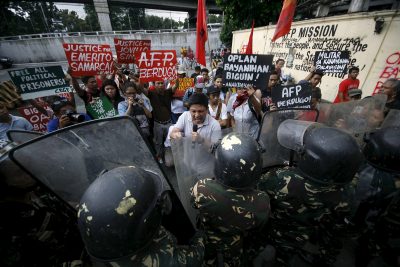Duterte has called for an end to ‘centuries of mistrust and warfare’ on Mindanao at his first State of the Nation address. This plea related to a consistent theme of President Duterte’s election campaign — how to secure peace and development in Mindanao.

He has acknowledged ‘historical injustices’ committed against the Muslim or Moro people and the need to correct them. He has also stated that he is ideally equipped to end the conflict which has been dragging on for almost half a century.
The Muslim populations of Mindanao and neighbouring small islands were subject to US colonial rule at the beginning of the 20th century. But mistrust of the Manila government and the mass migration of Christians from other more populated islands led to conflict and full-scale warfare in the 1970s.
Since then, there have been various peace initiatives by past presidents: the Tripoli Agreement of Ferdinand Marcos in 1976; the creation of the Autonomous Region in Muslim Mindanao (ARRM) under Corazon Aquino in 1989; the peace agreement with the Moro National Liberation Front (MNLF) in 1997 when Fidel Ramos was the president; and Benigno Aquino’s Comprehensive Agreement on the Bangsamoro in 2014.
With the latter agreement it was hoped that a final peace would be obtained. But the tragic massacre of 44 Special Action Force police in January 2015 derailed the passing of the Bangsamoro Basic Law (BBL) by Congress.
It is now President Duterte’s turn to pursue peace and he appears to have a combination of factors working in his favour.
First, he has prioritised peace in Mindanao, establishing it as an important agenda item at the beginning of his administration. This gives him ample time to hammer home his peace mantra and secure the support of a wide range of NGOs, the population and congress. And, he currently has the highest trust rating ever for a Philippine president, plus a ‘super majority’ in the congress.
Second, coming from Mindanao, he is credited with being more familiar with Mindanao politics and leaders than his presidential predecessors. As the Vice-Chairman of the Moro Islamic Liberation Front (MILF), Ghazali Jaafar recently stated of President Duterte, ‘No one will understand better the Moro issue but a Mindanaon’. Many others adhere to this view, especially in Mindanao.
Third, he has adopted an inclusive orientation involving the most significant Muslim groups, notably the MNLF, the MILF and politicians from the ARRM. A weakness of earlier agreements was that significant Muslim actors were often omitted, leading to antagonism or lack of cooperation.
This time, leaders of the MILF and MNLF have declared their trust in President Duterte and his ability to bring about a lasting and comprehensive peace agreement. They have even established formal arrangements for cooperation to ensure a united Moro front.
Finally, the choice of Jesus Dureza as Presidential Peace Adviser brings in another man of great Mindanao experience, including with earlier peace negotiations. Dureza has also indicated that he seeks to build on earlier work and that there should be a ‘peace dividend’ in the form of concrete developmental gains for the citizens of Mindanao.
But there is a long way to go to realise President Duterte’s ambitions of peace and potential problems lie ahead. One is the lack of clarity about the ‘roadmap’ to peace. In his State of the Nation address, President Duterte said he would ask the Congress to pass the BBL ‘minus the constitutional issues that are contentious’.
But apart from a police force under the control of the Bangsamoro authority, it is not clear what the other constitutional issues are. Nor will it be easy to get the Moro groups to agree to their omission from a final agreement or to get congress to pass the law.
Adding to the uncertainty is President Duterte’s determination to push through legislation for a federal system of government. He has provided no clear rationale for this dramatic change and no indication of how it would work.
While President Duterte is currently enjoying great popularity, this is not indefinite. The Mamasapano massacre resulted in a massive swing of public opinion against the BBL, including in Christian-majority areas of Mindanao. Current public opinion on the BBL is unknown. And it is not known how well cooperation between the different Moro groups will proceed.
The fragmentation of the MNLF into at least three factions could also be problematic. And violence created by the Abu Sayyaf and several other splinter groups opposed to peace could turn into a major obstacle if more people are kidnapped and killed and property destroyed.
Finally, a major stumbling block with previous peace agreements has been implementation. Moro groups have claimed that previous agreements were not fully implemented. Securing a peace agreement has proved to be the easier part of peace making in Mindanao. The future success of any peace agreement in Mindanao hinges on its implementation.
Mark Turner is Honorary Professor at the School of Business, UNSW Canberra.
http://www.eastasiaforum.org/2016/10/06/the-struggle-for-peace-in-mindanao/

No comments:
Post a Comment
Note: Only a member of this blog may post a comment.